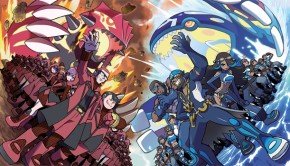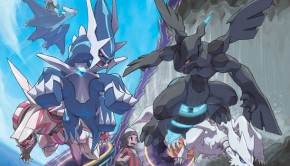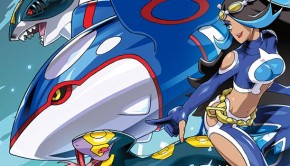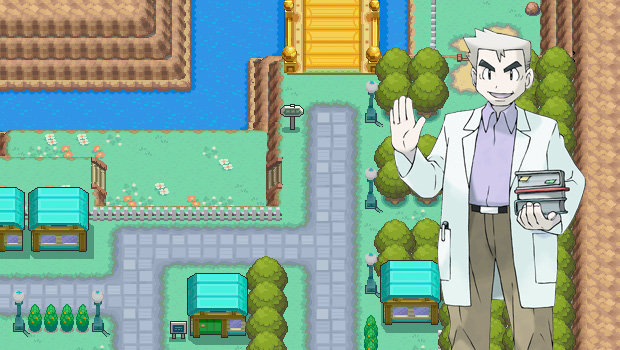A New Beginning for VGC ’13
We’ve come to the end of an era of VGC. Beginning next season, the format, whatever it may be, will include Black and White 2 — this is confirmed. What is not confirmed is what exactly the format will be. Currently there are two popular theories as to just what the next Regionals’ format will be. One theory is that the next season will add Pokemon Black 2 and Pokemon White 2 tutors and the new Therian formes to the VGC ’12 ruleset. This would be the simplest format to implement since it would simply mirror the current Global Battle Union ruleset. The other theory is that the rules used for the Beginning Cup — one of Japan’s WiFi tournaments — would be implemented. This doesn’t appear too difficult to implement but would be a deviation from the current setup and require a separate GBU ladder. Both of these ideas appear reasonable and familiar to an extent, with the first being a very modestly changed version of VGC ’12 and the latter a much more expanded version of VGC ’11. I believe that the Beginning Cup would be the superior option, but let’s take a closer look at what the effects of implementing these two rulesets would be.
Compared to VGC ’11, there were a lot more Pokemon that were used more than 1% of the time in VGC 2012 for a pretty apparent reason: There are more Pokemon to choose from. This means you have to test for longer periods of time to make sure your team is going to work properly against every check out there. You have to analyze, tweak, and find out if you can beat the less common Pokemon that just straight up counter your team. It gives me the marathon feel of the WiFi tournaments in testing form, and that is really not appealing. I would rather not spend more time than needed to pound out a good team. I want to put work in, and will do so regardless of how long it takes, but the amount of work that is needed to make a team, tweak it properly, and get comfortable with it in the VGC 2012 format is unreasonable, due in part to the variety of viable Pokemon.
Just for reference, here is a chart of the usage stats in the Skarmbliss VGC server metagame for each format. The % represents the percentage of teams the Pokemon was used on, and the numbers represent the usage ranking of that Pokemon. Data for VGC ’11 was taken from the April 2011 usage stats, while data for VGC ’12 was taken from the June 2012 usage stats. As you can see, VGC 2011 usage was much more exponential while the 2012 usage was slightly more moderate.
In 2011, there were very few Pokemon outside the top 40 most used that would even be considered viable. In 2012, that is definitely not the case. There’s way too much to account for and way too much to practice against to make it worth the time to try and find a completely optimal team. In 2011, however, there seemed to be too small a pool of viable Pokemon, which actually made it easier to throw a team together. This allowed some less skilled players to perform well in VGC tournaments. While this is good for the community’s and game’s growth, the competitive level of the game gets kicked down a notch or two. That seems to be the conundrum here: How does TPCi balance accessibility with competitiveness in one ruleset? A few major cogs in this decision can be put into place by asking questions related to the following topics:
- Competitive Level: How competitive is the top end of the game? Is it appealing enough to get people to play?
- Skill Variation: How far off is the top player from the average player? Is it possible to become good enough to challenge a top player in a reasonable amount of time?
- Diversity: Are there enough options to choose from in the proposed setup? Will the format become stale before the World Championships?
- Specific Issues: What are the main problems in the metagame due to the format?
Looking at these topics, there has to be balance and compromise. I’ll explain each one a little bit more in detail as it pertains to each format and give it a grade based on the evaluation.
Competitive Level
The top end of the game is extremely competitive, with the top 8 at the World Championships showing the best players in the world using some skillful tactics, deep predictions, and very well-built teams to support their playstyle. This is something the average player should admire and aspire to be like. The websites that host the VGC communities, especially here at Nugget Bridge, should be able to help players get a good understanding of what’s going on in those high-level matches and why each decision has been made. This is something that has to be done regardless of the metagame. As much as I don’t think this was a direct impact of the metagame style, it is something to note: Ray’s winning team in 2011 was much more outside the box than in 2012. What this means is pretty much the reader’s opinion, since there’s nothing to sufficiently explain either side’s point to validate it. Competitive level at the events seems to be reliant on the community keeping players in the loop, helping them understand what’s going on, and making it easier to pick up the tactics and use them themselves. This has very little to do with the metagame in my opinion, and is more of a result of the community and playerbase, alongside the top players keeping up on their tactics each year.
VGC 2011: 
VGC 2012: 
Beginning Cup: 
Skill Variation
When a new VGC player first walks into competition, they find themselves amidst a world of players that are pretty obviously more experienced than them. This is an issue for attracting new players. The format cannot allow for too much distance between the average player and the consistently good player as this discourages new players from play, but it also cannot aid the newer players too much at the same time without alienating the competitive core. This is an issue I feel has to have a perfect balance. The VGC 2011 format was definitely a more newbie-friendly setup: There were fewer Pokemon to learn, fewer teambuilding concepts to be concerned about, and fewer types of teams to worry about. In short, VGC ’11 was pretty straightforward and easy to pick up.
This may have made it a bit harder on the top-tier players, as it was harder for them to separate from the middle of the pack based on their skill level. VGC ’12, on the other hand, was much more biased to the top-tier of competitive players. It was very difficult for someone to pick up the game, especially mid-season, and expect to learn all the techniques and counterbalances, much less the Pokemon themselves, enough to be competitive at the highest level. One thing to take notice of though: The same nucleus of players that did well in 2011 also had a very good year in 2012. Was there that much of a competitive difference between the two seasons? Theoretically, yes. Realistically, not too much.
In the end, it is better not to have too much top-heaviness, and the community and the game is better off giving more players a chance to jump into the game, especially since the top players tend to keep playing at the highest level regardless.
VGC 2011: 
VGC 2012: 
Beginning Cup: 
Diversity
Sometimes playing a certain ruleset just becomes boring. In 2011 this was a major complaint since there were fewer than 50 Pokemon commonly used. In 2012, this also began to become a complaint around the time of the World Championships, as there were very few legitimate threats to the top-tier Pokemon. Is there a way to keep the usage rate from becoming too top-heavy? There is no definite answer, and I cannot back this up too much with hard facts (as much as I wish I could), but both 2011 and 2012 suffered from and overly centralized metagame. In 2011, some threats had no real counters, while in 2012 the top threats were statistically better than the other available options.
I believe the fix lies somewhere in between these two. A ruleset like Beginning Cup expands the available pool of Pokemon from the VGC ’11 ruleset but also restricts the VGC ’12 pool and cuts out many of the top threats that were previously dominant. It allows enough diversity to make matches interesting but does not push that diversity over the top and make teambuilding a marathon of a task.
VGC 2011: 
VGC 2012: 
Beginning Cup: 
Specific Issues
There are always a few issues that are specific to a metagame. They are preventable but annoying, and people will continue to abuse those metagame faults because they are the most effective.
2011: There were some major problems with games being decided by Rock Slide flinches, Thunder Wave, Spore, and Speed ties. Trick Room was also a difficult strategy to stop without brute force. Wolfe Glick’s Nationals team was extremely hard to stop regardless of how you prepared for it, and Ray Rizzo had to use a slot on his World Championship team specifically to stop Trick Room more effectively (Escavalier). With no particularly great counters to Pokemon like Terrakion, Thundurus, and Amoonguss, games frequently came down to who won the Speed tie or a Rock Slide flinch or a full paralysis or the most Sleep turns, which many players felt took control of their own performance out of their hands.
2012: The first major issue of the season was Garchomp’s Sand Veil. Some battles were decided simply because Sand Veil kept allowing Garchomp to dodge attacks that would otherwise have KO’d. Even though the likelihood of that happening was not that large in theory, it was enough to irritate people and cost players games they should have won. Thunder Wave was once more a problem, with overly bulky Pokemon like Cresselia using it alongside the typical Thundurus Prankster Thunder Wave. Later in the season, Swagger became obnoxious as players were using it as an out once they were pretty much hopeless in a battle, rather than specifically to boost their own Pokemon. It did make sense sometimes, but it was very problematic and resulted in a metagame that was too dependent on the RNG. While Thunder Wave and Swagger are likely to remain an issue no matter what metagame is played in 2013, there would not be a Pokemon like Cresselia that cannot be taken down in 1 to 2 hits most of the time spamming paralysis and confusion if the Beginning Cup rules were adopted. This will allow the use of Swagger on opponents to be checked more easily.
Beginning Cup: This is mostly conjecture, obviously, but there were a few things to take note of in the tournament. One, physical Pokemon were used a lot more heavily in the Japanese competition — there were 3 special attackers, 6 physical attackers, and 1 support Pokemon in the top 10 compared with the 2012 metagame’s bias towards special attackers. It’d be interesting to see this pan out a bit more as this is only one tournament, but a more physical metagame would be a very different feel from past years, despite the presence of some familiar faces. The one Pokemon that stood out to me was the aqua bunny, Azumarill, which was the 10th most used Pokemon in the tournament. This is especially notable because it has never been seen on a top team in 2012. The increase in diversity of attackers and surprising threats like Azumarill speaks well of Beginning Cup’s ability to create a diverse metagame.
It doesn’t really look like the Beginning Cup provides a clear answer to the specific issues from 2012 and 2011, and we can’t quite tell what the metagame would look like after a few months in, but there are improvements. The main problems from 2012 are gone (Cresselia, Latios, Garchomp, Heatran, Zapdos, Hitmontop, Politoed) while the ones from 2011 that persist (Terrakion, Amoonguss, Chandelure) have to contend with the new additions like Azumarill. It would be interesting to see a metagame with 2012’s problems gone but with more reasonable checks to 2011 problems.
2011:  and sometimes
and sometimes 
2012:  and sometimes
and sometimes 
Beginning Cup: 
Final Thoughts
Overall, the Beginning Cup shows some promise as a more balanced format with a less problematic metagame. We won’t know for sure until it’s played more, obviously, but there appear to be more pros than cons. To conclude, the ideas I would say are the biggest factors for this to be the preferred format for the remainder of the 2013 season:
- Good variation, but not too much. There are still a lot of options, but the problems from 2011 are more efficiently checked, and the problems from 2012 are mostly eliminated. This creates an entirely new game, which looks more preferable at this junction. I’m not saying that it couldn’t go wrong, but it has a much better prospective feel to it.
- Teambuilding won’t be too easy or too hard. Teambuilding should efficiently balance time and skill. Building teams in 2011 was pretty simple since you could throw almost anything from a short list of Pokemon together and make it work without much skill involved, and in 2012, it took so much more time to build an effective team because there were more things to check and problems such as Cresselia, weather control, and stopping status still had to be dealt with. Creating even a half decent team took an extreme amount of work, and going through the process over and over and over again throughout the season was not amusing.
- It won’t be too hard to pick up for newer players. The 2011 metagame was my first year, and looking back, it was way too easy for me to learn. I was able to qualify for Nationals at my first event ever with Pokemon that were far from the standard (Chandelure with Flame Burst, Terrakion with Brick Break… Let’s just say I have come a ways since then). That had to be pretty frustrating for the players who couldn’t qualify and put in a ton more work and, quite frankly, had a lot more skill and knowledge than I did. On the other hand, 2012 was too much for new players to take in, as there were about 150 Pokemon and their respective abilities, moves, and tactics to learn.
- It will market Pokemon Black and White 2. If the tutors, Therian formes, and other sorts of BW2 exclusives are allowed, it will definitely help the marketability of the game. If making it mandatory for use at Winter Regionals won’t be enough marketing, this will help it along even more.
Beyond this, there is one other issue I should bring up that I touched on in the intro paragraph: WiFi. Right now, GBU Doubles is set at VGC 2012 + BW2 modifications. The format for Beginning Cup is programmed since there has been a Japanese tournament with it, so I would assume that it would not take a ton of time to implement as the main format for GBU doubles. However, it would be an issue if it weren’t. Players need a space to practice for VGC tournaments, and the GBU provides one of the better practice outlets. If the GBU and the official VGC Modified format don’t match up, players would lose one of their best practice outlets. The best solution, in my opinion, is to implement Beginning Cup as the main GBU format beginning at Season 8 (Christmas Day), and holding a tournament or two before that so we could continue to practice. The tournaments would be quick fixes in order to buy the developers time to implement the Beginning Cup as the next format.
I’m not saying Beginning Cup is flawless — no format is going to be flawless — but it looks like a well-rounded option which mostly fixes the problems of the past. In hindsight, if this turns out to be the format and the metagame goes haywire, I’ll admit I was wrong, but from this vantage point, the only complaint that I could really see being justified is having to learn a whole new format and meta. I have my doubts that any of the Beginning Cup’s potential problems could be worse than Terrakion and Thundurus in 2011 or Cresselia and Garchomp in 2012. It seems like the threats check each other pretty well, and the amount of top-tier Pokemon should increase since there will be more viable checks to the common threats. There won’t be enough to eliminate them from being threats, but there will be enough to stabilize things a bit. We could see a nice revolving door of Pokemon with a new format, and that would be some fresh air after the last two years of top-heavy dominance.











